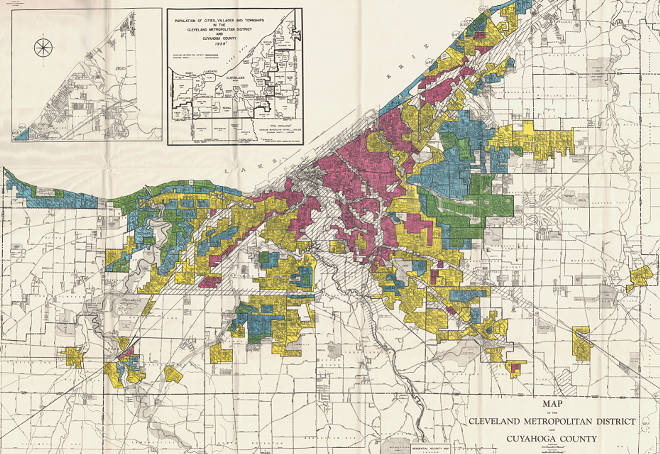[
{
"name": "Real 1 Player (r2) - Inline",
"component": "38482494",
"insertPoint": "2/3",
"requiredCountToDisplay": "9"
}
]
Neighborhoods with Black residents were 40 times more likely to be redlined in the 1930s, according to new research from Case Western Reserve University, confirming racism as the defining factor of the practice whose effects are still felt today.
In real estate, redlining refers to the process of denying home loans in areas determined to be investment risks.
With the enactment of the New Deal in the 1930s, the federal government established the Federal Housing Administration and the Home Owners’ Loan Corporation (HOLC) to help Americans buy homes.
HOLC created investment risk maps with areas labeled green for best, blue for still desirable, yellow for declining and red for hazardous -– hence the term redlining. These redlined areas were ineligible for home loans guaranteed by the government and real estate textbooks specifically warned about areas with Black residents.
Using archival maps and area description forms by HOLC from 1934 to 1940 for 568 Ohio neighborhoods, researchers extracted data to determine the extent that racism and other factors weighed into mortgage application decisions by real-estate professionals, loan officers and appraisers.
“This study really helped us understand what determined which things were the most salient in the decision to redline a neighborhood,” said associate professor in medicine and sociology Adam Perzynski, who co-authored the study.
Although factors like housing conditions, vacancy rates and xenophobia contributed to decisions, Perzynski says “racial discrimination was the overriding factor in decisions to redline neighborhoods."
Although redlining was officially outlawed by the Fair Housing Act in 1968, its legacy endures. Poverty, life expectancy, and access to resources are real and present consequences in 2023.
“We’ve created these neighborhoods,” said co-author and assistant professor at the school of medicine Kristen Berg. “These are the consequences of deeply intentional policy decisions. There needs to be intentional work, then, to transform neighborhoods and invest in families whose generations have been harmed by redlining.”
Researchers say they hope their findings will influence social, health and economic policy.
“When we look at redlining, we have to think about the consequences of racist policies,” Perzynski said. “Community gardens are a good thing and managing blood pressure is never a bad idea, but they don’t correct 100 years of discrimination and institutionalized racism.”
Today white home ownership in Ohio is 73.1%, compared to just 34.7% for Blacks.
Among ideas they would like to see, researchers cited community investments in these historically neglected and marginalized areas and reparations like those introduced in Evanston, Illinois.
The findings were published in the Du Bois Review, a peer-reviewed academic journal with a focus on social science research on race.
Coming soon: Cleveland Scene Daily newsletter. We’ll send you a handful of interesting Cleveland stories every morning. Subscribe now to not miss a thing.
Follow us: Google News | NewsBreak | Instagram | Facebook | Twitter










